The Best Triathlon Bikes of 2025
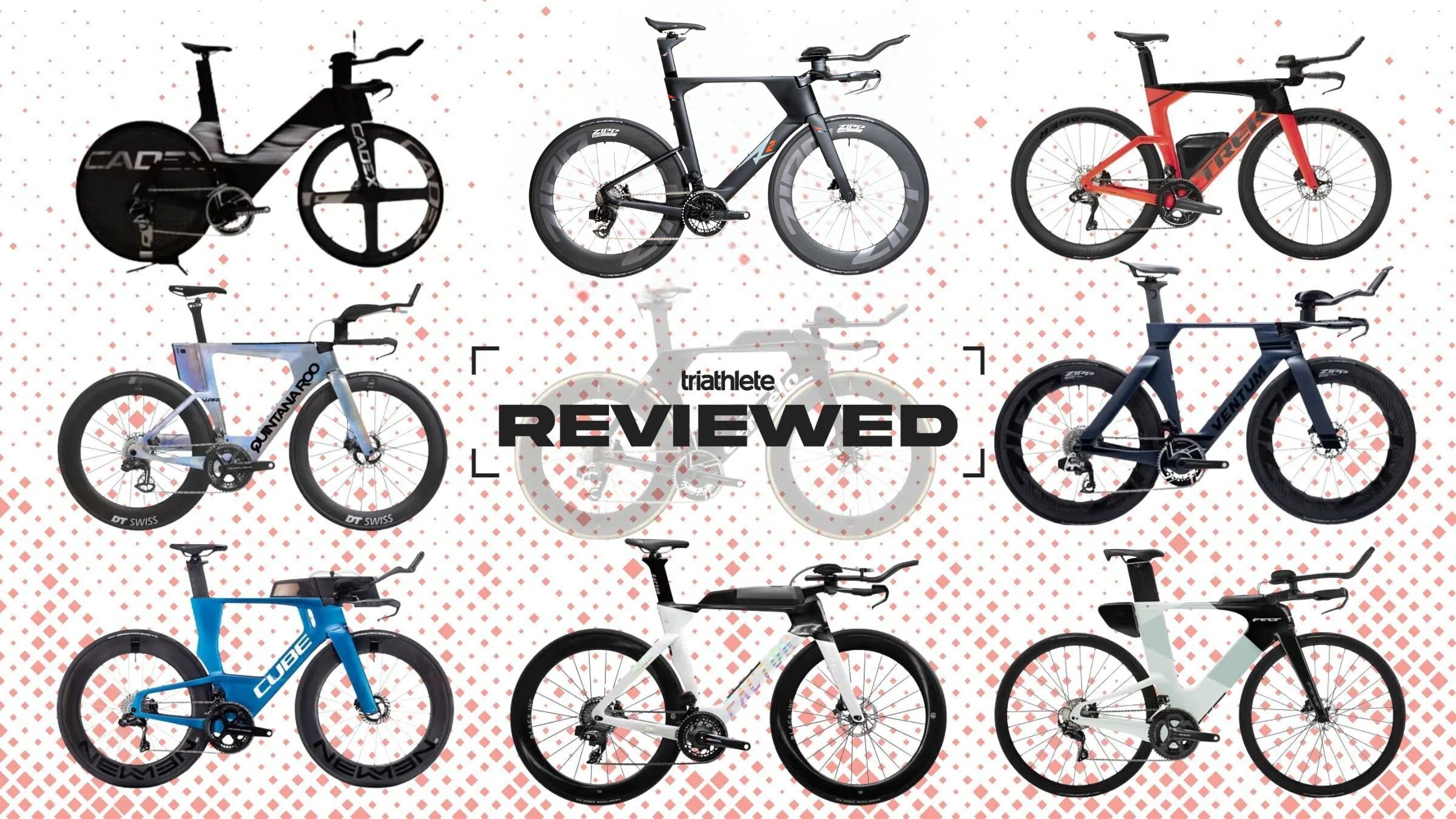
Triathlete presents the best triathlon bikes of 2025 from A2 Cervelo, Trek, Felt, Cube, Quintana Roo, Cadex, Factor, and more. (Photo: Triathlete)
Best Triathlon Bikes 2024
The last 12 months have continued to see some exciting new releases in the tri bike space – both Ventum and Factor have not only introduced brand-new 2024-2025 models, but both are models that actually bring the price entry point down on both brands. This is a good thing for athletes looking to get the best triathlon bike (for them) in 2025, as there are now more somewhat affordable options available.
Also new this year, we’ve learned quite a bit about what you, the reader, is actually looking for (and buying) in the best triathlon bike in 2025 – thanks to the results from our 2025 Triathlete reader survey.
What are the most popular triathlon bikes in 2025?
Similar to the annual Ironman World Championship Kona and Nice bike counts, we’ve learned that the majority of triathletes still own Cervelo bikes – despite the fact that the brand doesn’t typically release new models, only updates on previous ones. At roughly 24% we see Cervelo has a solid lead over second-place Quintana Roo (20%) – a tri-specific brand – and Trek (18%) – a brand that’s not tri-specific.
How much do triathlon bikes cost in 2025?
According to our survey, a surprising amount of triathletes spend over $10,000 on their bikes (16%), while the largest chunk of triathletes actually spend between $3,000-7,500 on their bikes (57% of respondents), which means that triathletes should be interested in the two new bikes from Ventum and Factor, as they fall into those two sweet spots.
Read on below for nine of the latest (and best) triathlon bikes in 2025, hands-on tested with unbiased reviews and ratings.
| Criteria | Description |
| Sizes Offered | While most bike brands can fit almost every body with some adjusting, models with a greater number of frame sizes will fit easier and handle better. |
| Fit Range | This is not only the number of sizes offered, but also the range from smallest to largest. Obviously tri bikes can (and should) be adapted by a good fitter, and a fitter should ideally be consulted even before purchasing a bike, but this rating details how much adjustment (i.e., aerobar spacers, alternate saddle positions, etc) from the frame’s baseline could be required to get an optimal fit. |
| Value | Here we look at the value behind the complete bike, looking mostly at components, but also frame quality as well. This is not just absolute price from low to high. |
| Comfort | This rating specifically judges the complete bike on vertical compliance, not fit or handling. Keep in mind that more than just a frame can affect comfort, and since we evaluate the complete bike as it’s sold, other components can come into play - wheels, tires, even bars. |
| Acceleration Stiffness | This is another rating that looks at the sum of the parts on the complete build. Here we’re evaluating how the bike responds under high torque (standing up over a hill or out of a corner) and high wattage (powering over a roller). Again, other components aside from the frame can come into play here. |
| Handling Tightness | Separate from stability, this is the rating that scores how sharp the bike cuts corners. This isn’t necessarily a positive thing if you prefer a bike that sweeps more reliably through corners, as opposed to a bike that can turn on a dime. 5/5 here is very tight handling; 1 / 5 is a bike that swoops out on corners but might be more consistent. |
| Stability | This rating looks at how stable a bike feels in the aerobars in crosswinds and on descents. A more stable bike will require less input from the rider to stay straight, but again, it looks at the complete bike as a whole - wheels included. |
| Best Distance | This is a quick look at which distance tri the bike will be good for, out of the box. Of course pretty much all the bikes we review work for almost any distance, but these distances are where each complete bike - as shipped - will shine. |
| Ease of Assembly | With so many bike brands using the direct-to-consumer model, we rate how easy the home build would be for the average triathlete. Here, we’re assuming a low level of mechanical skill - for instance, the person we’re rating for could change a tire, but maybe not adjust a derailleur. |
| Integrated Hydration | This rating considers the ease of use in using, refilling, installing, and cleaning the bike’s integrated hydration, if available. |
| Volume of Integrated Hydration | As many of today’s high-end triathlon bikes offer integrated hydration, we note how much volume the bike can store, out of the box. |
While the gear below was loaned out by the brands represented, all choices were selected independently by the tester without any promotional consideration or brand input. Also, unlike other “best triathlon bike review” websites, our testers actually build and ride each of the bikes ourselves – no glancing at spec sheets and rewording marketing terms! Learn more about Triathlete’s gear review process here.
Best triathlon bikes of 2025
Ventum Tempus
Starting at $5,000. $11,000 as tested, 19 lbs. 15 oz. (size L, no hydration), Sram Red AXS 12-Speed Build, Zipp 858 NSW Wheels
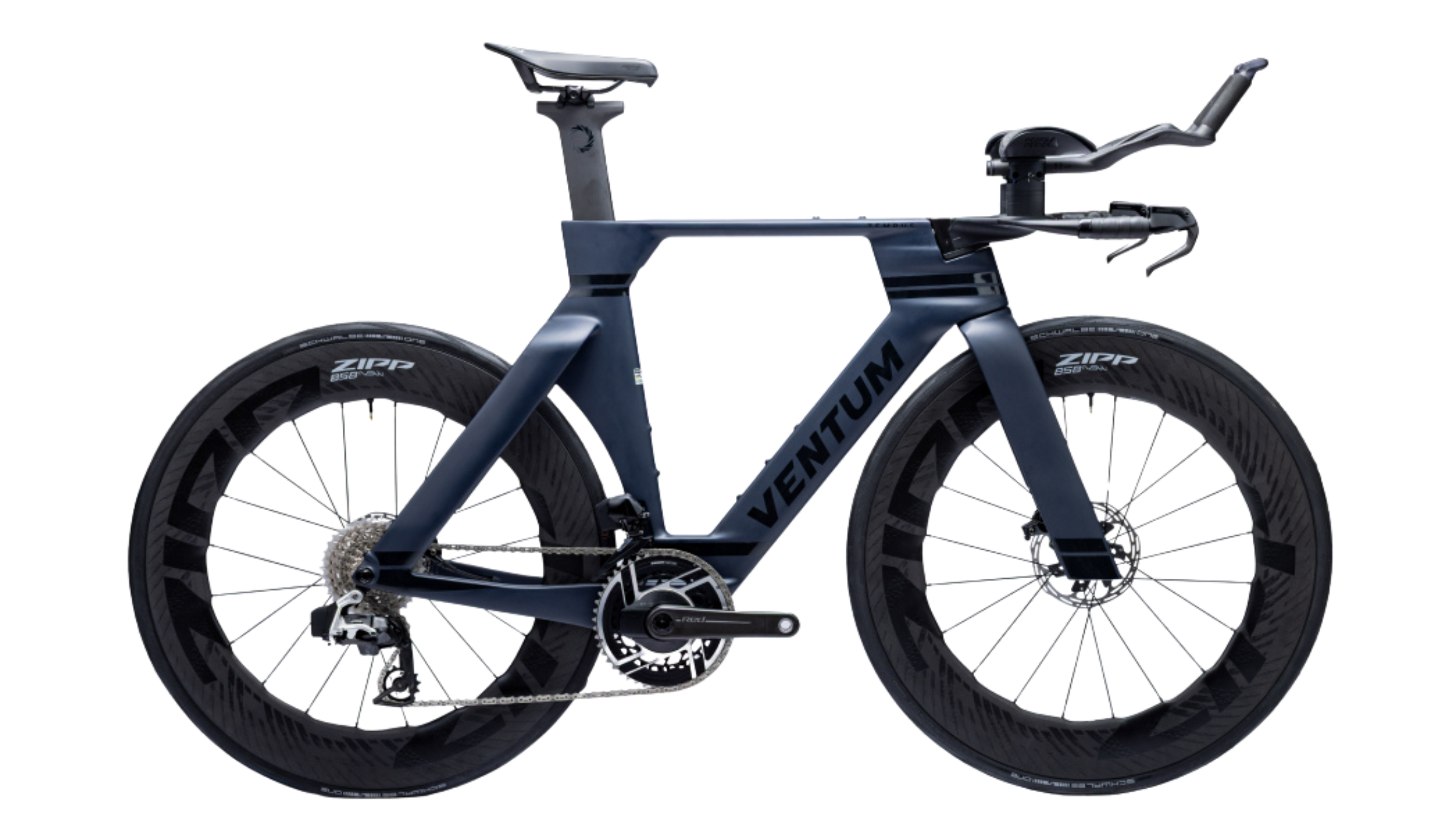
| Best Triathlon Bikes Category | Rating |
| Overall Rating | ★★★★ |
| Sizes Offered | 4 |
| Fit Range | ★★★ |
| Value | ★★★★★ |
| Comfort | ★★★★ |
| Acceleration Stiffness | ★★★ |
| Handling Tightness | ★★★★ |
| Stability | ★★★ |
| Ease of Assembly | ★★★★ |
| Best Distance | All distances |
| Integrated Hydration | None |
| Volume of Integrated Hydration | None |
When Ventum announced a new bike at last year’s men’s Ironman World Championship in Kona, I couldn’t wait. Best known for not only pushing the envelope with a fantastic non-double-diamond design, but also for sticking to their guns with a design that was for triathletes, by triathletes, with no compromises. The Ventum One was a bold, super-fast design with integrated hydration and nutrition – weight and UCI limits be damned. So when I learned that Ventum was releasing their first traditional, double-diamond triathlon bike – one without any integrated nutrition or hydration at that – I was a little skeptical.
Flash forward to 2025, when I had some time to put miles on the new Ventum Tempus, and I’m pleasantly surprised with a very affordable, accessible triathlon bike that probably serves the needs of a greater population of triathletes who might not be racing iron-distance events – all starting at $5,000.
And while the Tempus isn’t perfect – I found it to be a little on the twitchy side when it comes to stability at high speeds in dicey crosswinds – it’s still a strong showing in a time when most other brands are going only premium or ultra-premium. The Tempus competes well against the Cervelo P-Series, outpaces the Felt IAx (in my opinion), and probably only falls behind the similarly priced Quintana Roo X-PR when it comes to fit flexibility (the Tempus sadly only has four sizes) and tri-specificity (see: the fact that the Tempus has no integrated hydration/nutrition and is UCI legal). All that said, the Ventum Tempus is a great addition to the entry-midrange tri bike market that can work for the athletic lifespan of any triathlete.
Read the full Ventum Tempus early look.
Factor Slick
Starting at $7,800. $10,400 as tested, 18 lbs. 13oz. (size 56, with hydration), Sram Red AXS 12-Speed Build, Black Inc Sixty Two Wheels
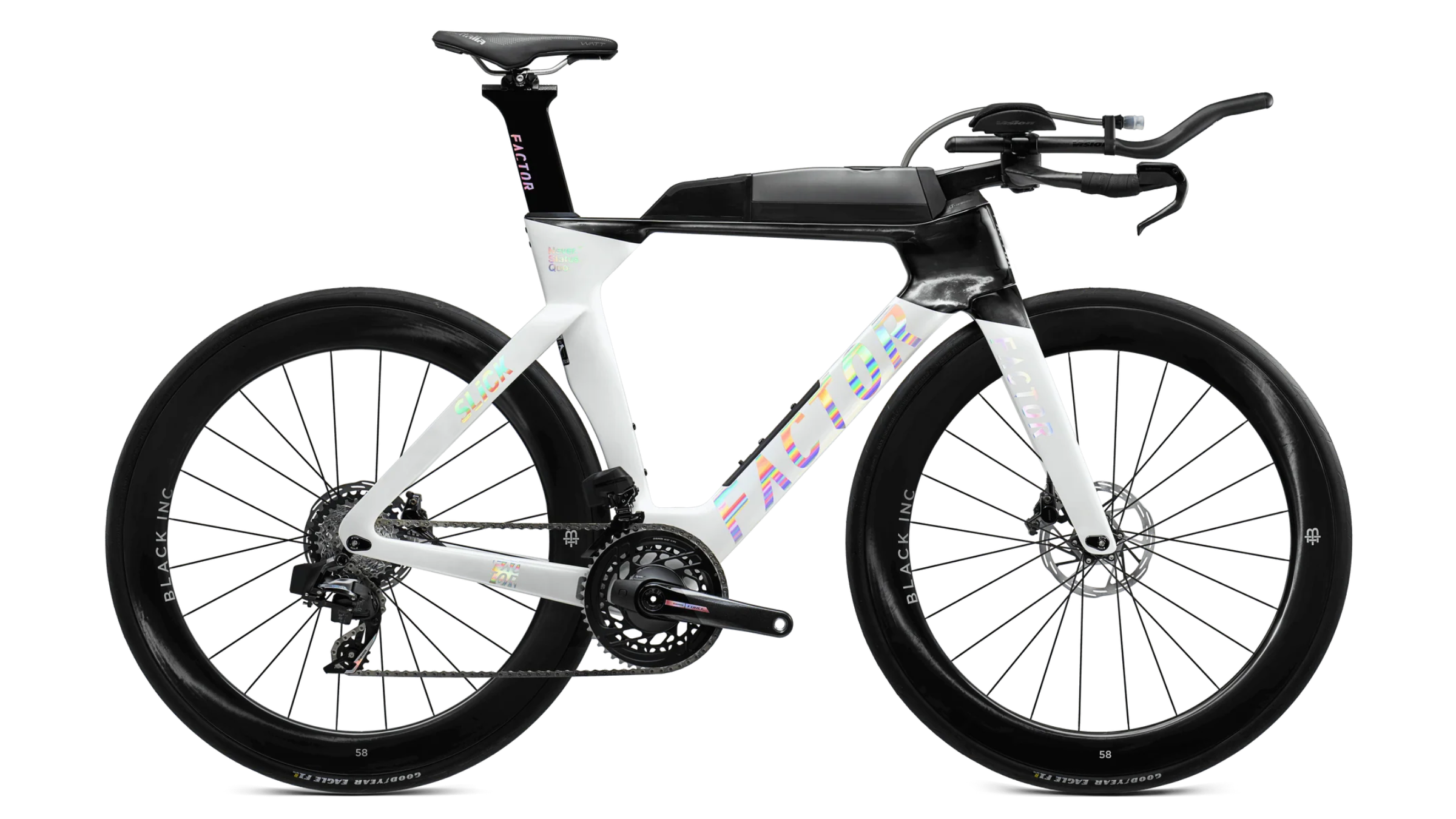
| Best Triathlon Bikes Category | Rating |
| Overall Rating | ★★★★ |
| Sizes Offered | 5 |
| Fit Range | ★★★★ |
| Value | ★★★ |
| Comfort | ★★★★ |
| Acceleration Stiffness | ★★★ |
| Handling Tightness | ★★★★ |
| Stability | ★★★★ |
| Ease of Assembly | ★★ |
| Best Distance | All Distances |
| Integrated Hydration | ★★★ |
| Volume of Integrated Hydration | 600mL |
Factor might not be a super familiar name to most North American triathletes, but that could definitely change. In the past, Factor offered only ultra-premium framesets in its Hanzo, but with the introduction of the much more affordable Slick, this is a bike more people can afford. Starting at $7,800 for a race-ready Sram Force build (with power meter), but also available as a $5,000 frameset option, the Factor Slick is far from an entry-level bike, but it’s a fantastic choice for someone looking to break out of the $3-5,000 range.
In my testing, I found the Slick to be without fault. It soaked up road chatter like the best double-diamond bikes, and was definitely in the top-five most stable handling bikes – both characteristics that would make the Slick a great triathlon-specific bike at any distance, all the way up to Ironman. It handled admirably in unpredictable headwinds and crosswinds, only coming up slightly short in exceptionally fast, steep, and wild situations – a place where most tri bikes struggle anyway.
In terms of cornering and acceleration (less important factors, in my opinion), the Slick was about midpack, feeling predictable and somewhat energetic, but not necessarily scalpel-like nor something that would win you a town line sprint (but why would you want to?). Certainly, the Slick’s crazy light weight is worth noting, as is the fact that it comes with a very handy downtube storage “trap door” and somewhat integrated hydration and nutrition storage. Located on the top tube, the 600mL of hydration storage is adequate, but since it’s not a ton the “just OK” hydration lid makes refilling more challenging than other similar designs. Overall, this is a fantastic bike, but in terms of something “triathlete only” the fact that Factor went with a UCI-legal design likely means they left some speed and storage on the table. Nonetheless, for under $8,000 this is still a solid option.
Cervelo P5 (2024 version)
Starting at $10,500. $14,250 as tested, 20 lbs. 5oz. (size 56, with bottle), Shimano Dura Ace Di2 12-Speed Build, Reserve 77/88 Wheels
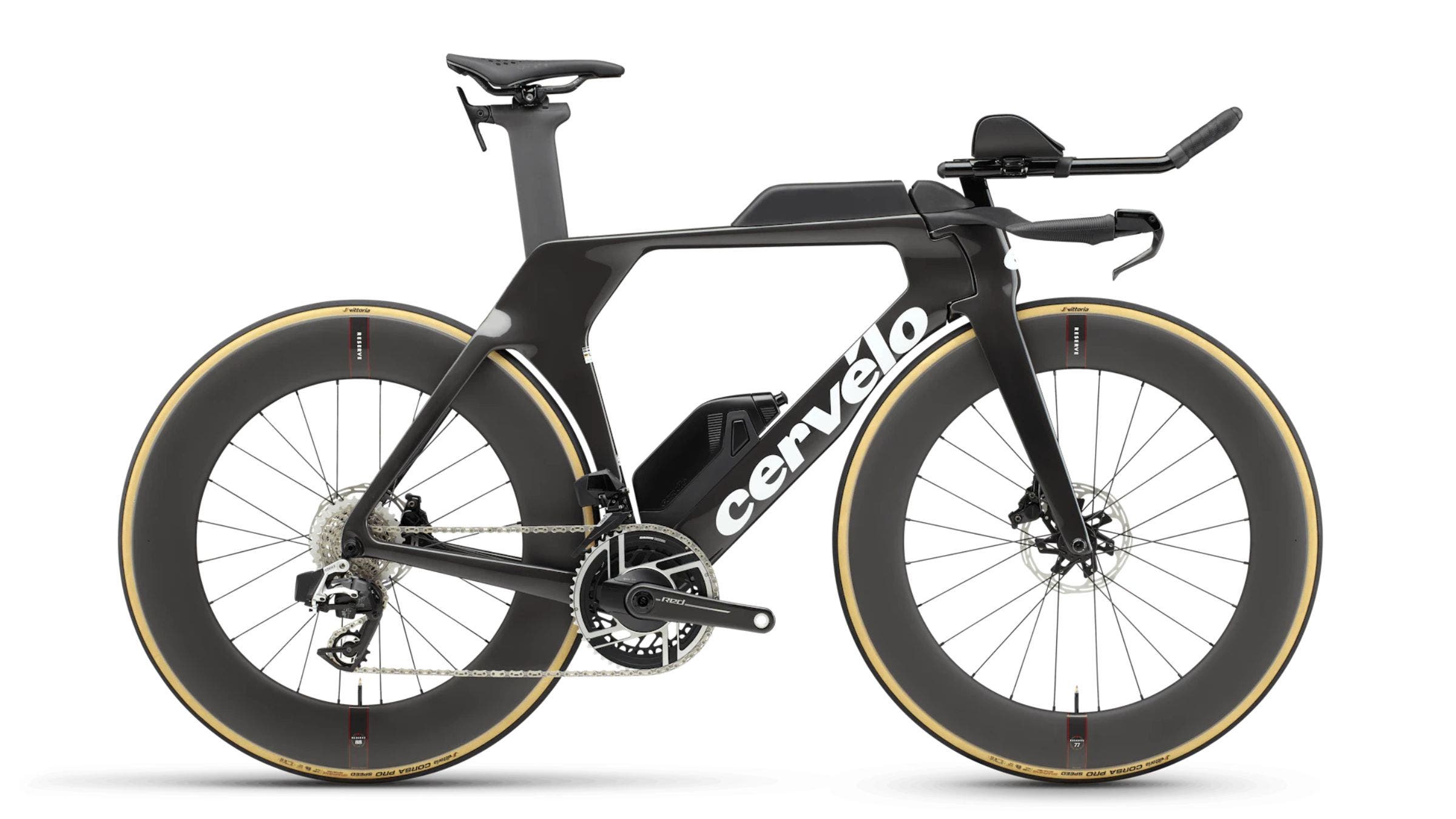
| Best Triathlon Bikes Category | Rating |
| Overall Rating | ★★★★ |
| Sizes Offered | 6 |
| Fit Range | ★★★★★ |
| Value | ★★ |
| Comfort | ★★★ |
| Acceleration Stiffness | ★★★★★ |
| Handling Tightness | ★★★★★ |
| Stability | ★★★ |
| Ease of Assembly | Not D2C |
| Best Distance | 70.3 and under |
| Integrated hydration | ★★ |
| Volume of Integrated Hydration | 500mL |
Though it’s barely an update to the Cervelo P5 that was released about five years ago, the 2024 version is still one of the top triathlon bikes when it comes to lateral stiffness, weight, and handling. Though the price tag is steep, interested buyers need to still consider purchasing additional hydration, as the P5 still only comes with a 500mL frame-mounted water bottle that can’t realistically be refilled mid-race and a rear-mount bottle bracket. However, there is space for hydration between-the-arms with the included aerobars.
Like the previous P5, the 2024 edition tracks well on straight lines, and eats up bumps well enough, but for long-course racing with gusty crosswinds, super rough roads, or long, endless straightaways, there are better choices for stability, comfort, and aerodynamics, as the P5 is still subject to the design rules enforced by the UCI. That said, the new P5 is offered in more sizes with greater front-end fit flexibility – the simplified front end also helps the P5 cement its best-in-class handling capabilities.
Read more in our extended review of the 2024 version of the Cervelo P5.
Quintana Roo V-PRi
Starting at $11,600. $14,329 as tested, 20 lbs. 12oz. (size M, with storage, integrated hydration), Shimano Dura Ace Di2 12-Speed Build, HED Vanquish Pro V62/V84 Wheels
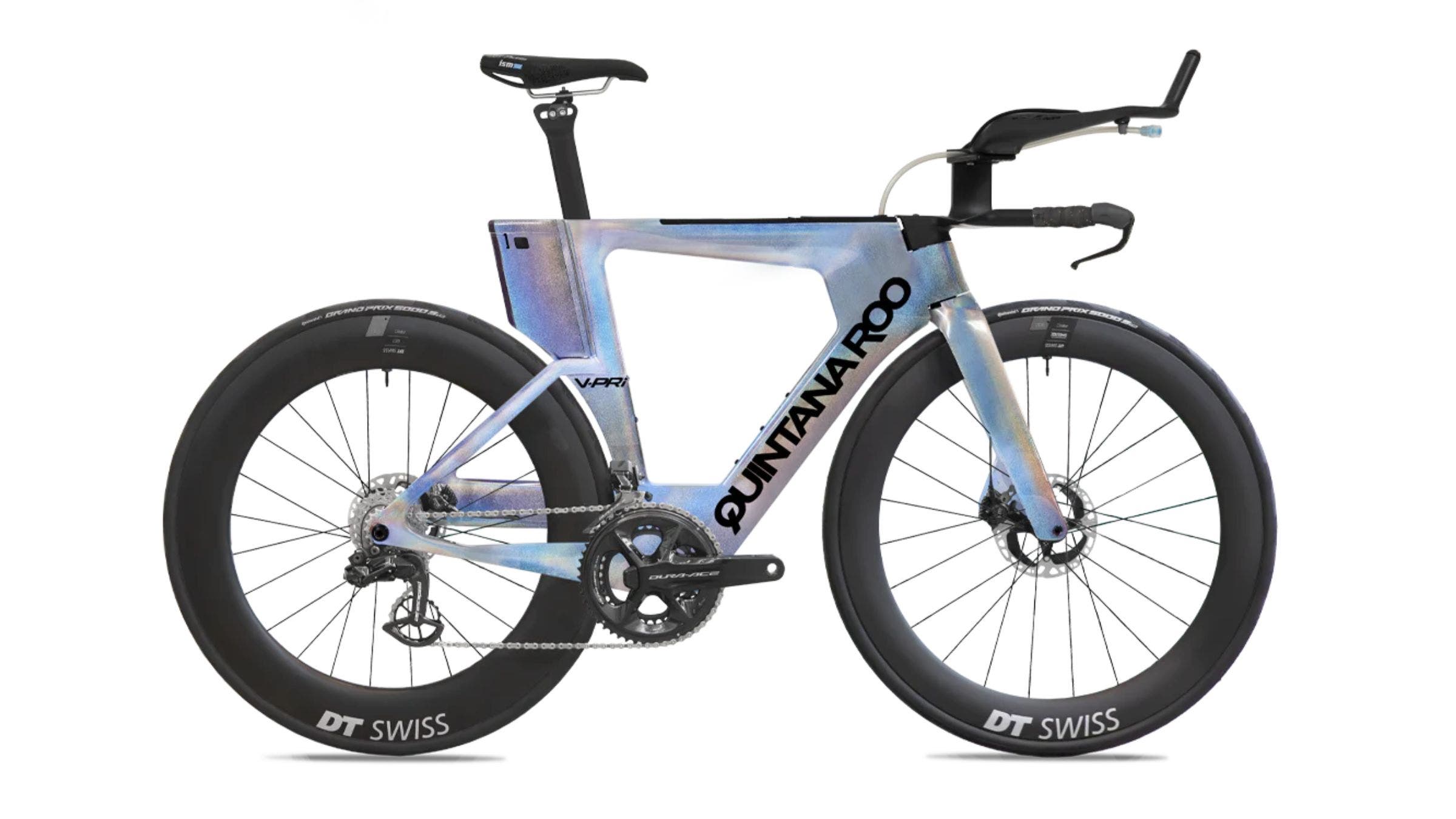
| Best Triathlon Bikes Category | Rating |
| Overall Rating | ★★★★★ |
| Sizes Offered | 3 |
| Fit Range | ★★ |
| Value | ★★★ |
| Comfort | ★★★★★ |
| Acceleration Stiffness | ★★★★ |
| Handling Tightness | ★★★★ |
| Stability | ★★★★★ |
| Ease of Assembly | ★★★★ |
| Best Distance | 70.3 and above |
| Integrated Hydration | ★★★★★ |
| Volume of Integrated Hydration | 650 mL (size S), 750 mL (size M, L) |
Quintana Roo’s new V-PRi retains the characteristics that have made the V-PR line a favorite among long-course racers: near-autopilot straight-line tracking (in any condition), excellent vibration absorption, and high-end aerodynamics. The new iteration from Quintana Roo also includes virtually invisible, integrated hydration for the first time, with best-in-class results – easy to use, fill, and clean. The V-PRi is also the first time Quintana Roo has departed from a wide range of sizes (typically six) and reduced their offerings to three.
That said, assuming you can fit one of the three options (there is a wide range of front-end fit flexibility to help), you won’t find a better and more flawlessly designed long-course machine. With the introduction (finally) of fully integrated hydration and nutrition, and a super-tidy front end, this is one of the fastest (looking, anyway) and ready-to-race superbikes, right out of the box. There’s nothing wrong with racing an Olympic-distance event with the V-PRi, but this bike will shine on all but the twistiest and hilliest long-course bike legs – in any conditions – and because there’s flexibility in the aerobars, there’s space for additional hydration, if needed.
Read more in our extended review of the Quintana Roo V-PRi.
Felt IAx
$3,700 as tested, 23 lbs. 2oz. (size 56, with storage), Shimano 105 12-Speed Build, Devox WheelRDS.A1 Wheels
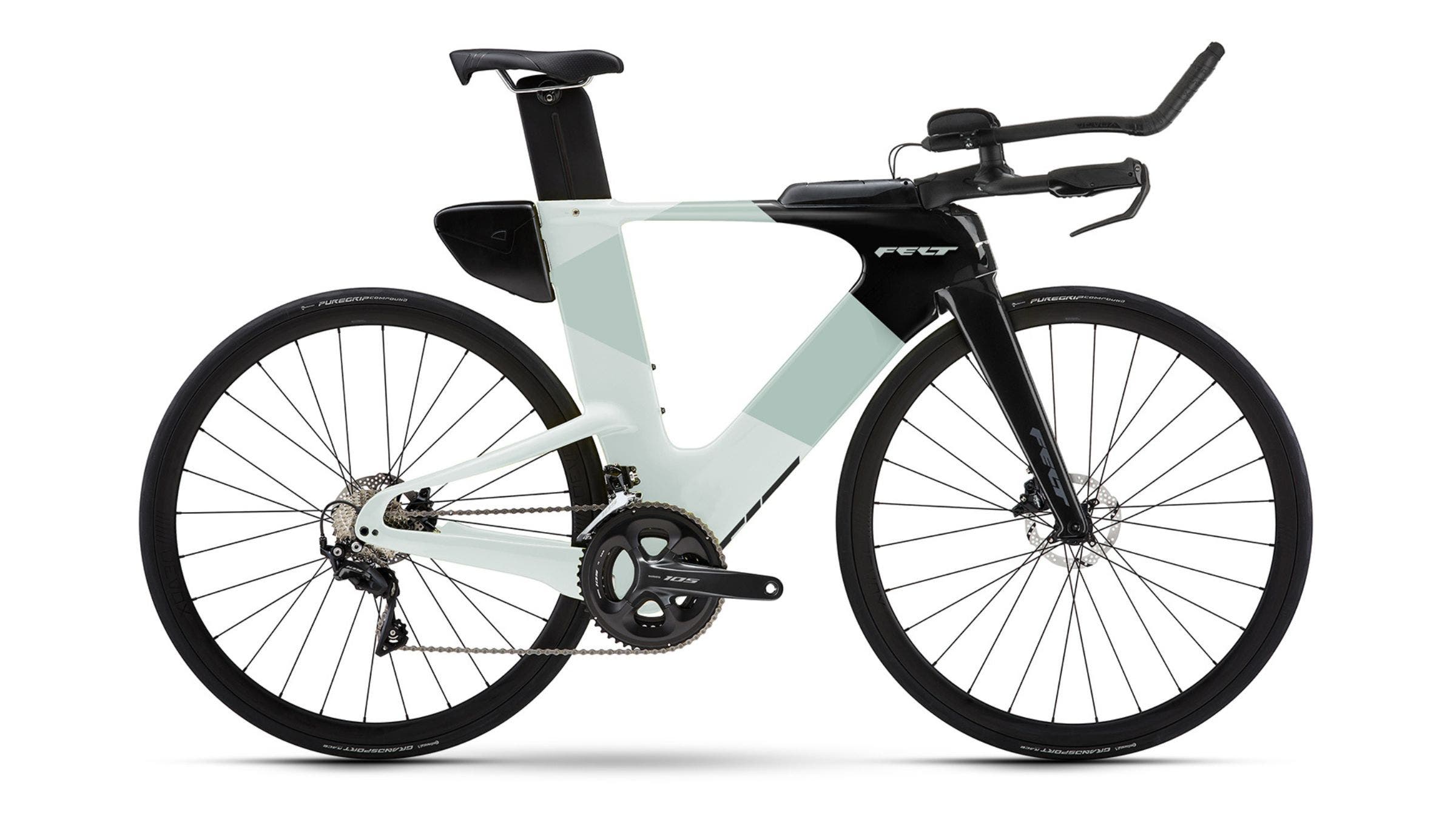
| Best Triathlon Bikes Category | Rating |
| Overall Rating | ★★★★ |
| Sizes Offered | 5 |
| Fit Range | ★★★★ |
| Value | ★★★★ |
| Comfort | ★★★★ |
| Acceleration Stiffness | ★★★ |
| Handling Tightness | ★★ |
| Stability | ★★★★ |
| Ease of Assembly | Not D2C |
| Best Distance | All distances |
| Integrated Hydration | None |
| Volume of Integrated Hydration | None |
With a long-awaited refresh to Felt’s sub-$5,000 pricepoint lineup, the new Felt IAx boasts tons of superbike features, like ultra-deep carbon sections in the head tube area, the downtube, the seat tube (and seat post), alongside a low seat/chainstay section to help keep clear air clean. Despite the fact that this is one of the few mechanical shifting options on the 2024 list, the Shimano 105 12-speed groupset is shockingly complete and includes hydraulic disc brakes – a rare thing for less than $4,000.
Though the Felt IAx is one of the heavier bikes we’ve tested recently, its “bones” make it a great foundation to build an all-distance race rig with near-limitless potential. Because the design mirrors Felt’s aerodynamics on bikes well over twice the price, simply upgrading the wheels and/or the components as you go can make this a superbike-level performer. It is worth noting, however, that the IAx has some top-tube nutrition storage, but no hydration storage built in (like all bikes at this price, to be fair), so you’ll likely need to add even more weight, in the form of hydration storage if you’re going to carry it all in a long-course event.
Read more in our extended review of the Felt IAx.
Cube Aerium C:68X SLT
$9,000 as tested, 22 lbs. 4oz. (size M, with integrated hydration), Shimano Dura-Ace Di2 12-speed, Newmen Advanced SL R.80 Streem
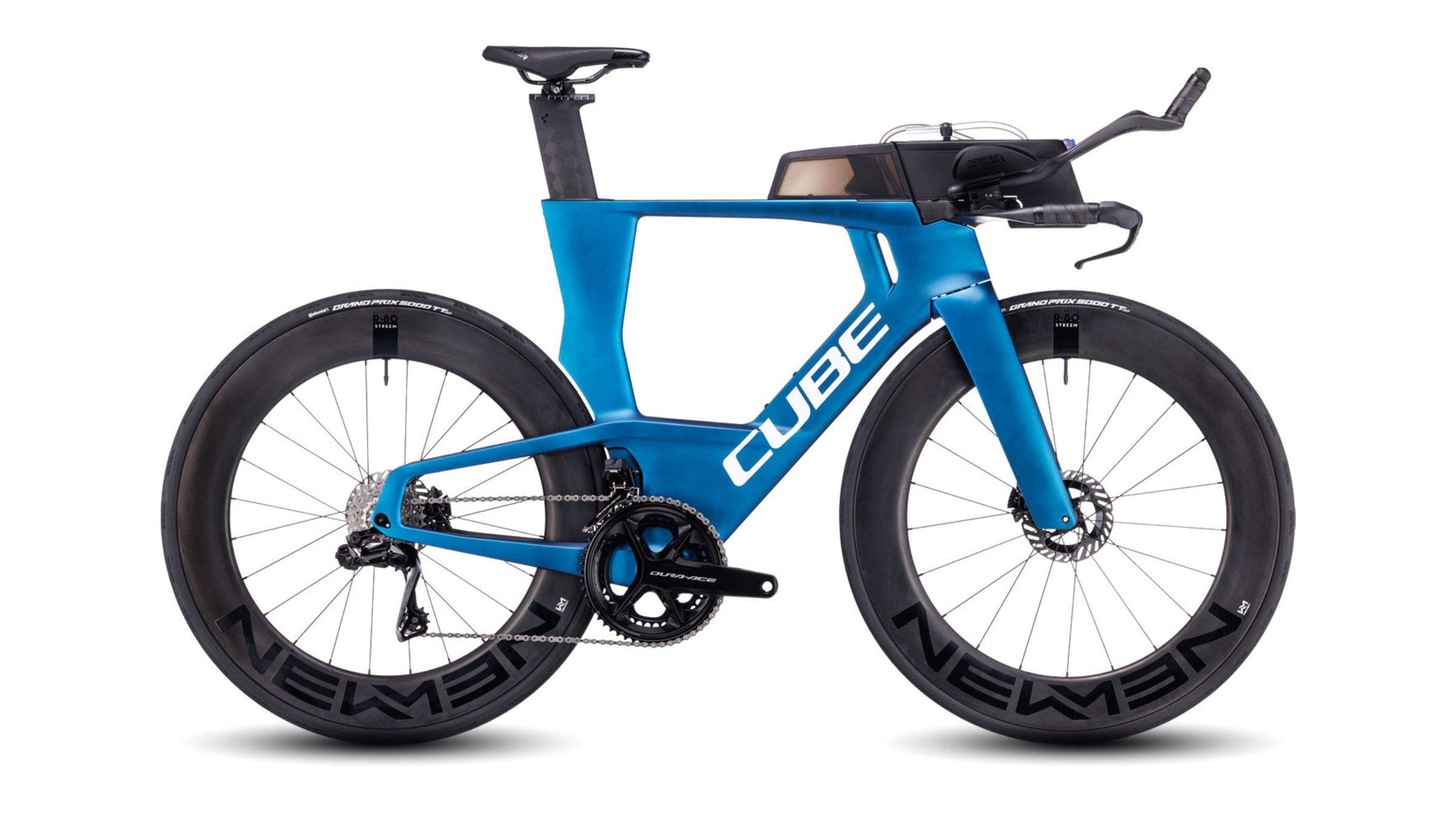
| Best Triathlon Bikes Category | Rating |
| Overall Rating | ★★★★ |
| Sizes Offered | 4 |
| Fit Range | ★★★★ |
| Value | ★★★★★ |
| Comfort | ★★★★ |
| Acceleration Stiffness | ★★★ |
| Handling Tightness | ★★★ |
| Stability | ★★★★ |
| Ease of Assembly | Not D2C |
| Best Distance | All distances |
| Integrated Hydration | ★★★ |
| Volume of Integrated Hydration | 1,500 mL |
The Cube Aerium C:68X is one of the bikes I was most excited to try out in the last 12 months, quite simply because it was one of the most visible in Kona back in 2023 – being ridden off the front of the race, with no one else in sight by eventual winner Lucy Charles-Barclay for just over four-and-a-half hours. And yet despite its hours of TV time, this bike is relatively difficult to find in the U.S.
The good news is that Cube’s new tri bike is all tri bike, purposely built for multisport, and not trying to fit into the UCI’s little rule book. From the incredible crosswind handling and straight-line stability to the super-smooth ride and nearly limitless nutrition storage options, this is a top-shelf triathlon bike through and through.
I loved almost everything on the bike – including the fact that just under $10,000 for a full Shimano Dura-Ace Di2 build with great 80mm race-day wheels is actually a very, very good deal. In fact, the Aerium sits in the top two tri bikes, in my tests, for the last two years. The only small caveat was the in-frame hydration bladder that took a bit more work to set up and use properly than others, but once dialed in worked well (the included between-the-arms hydration system worked like a charm immediately). It’s no surprise that this incredibly well-rounded bike took Charles-Barclay to victory.
Updated for 2025, the SLT I tested now comes with a Dura-Ace power meter crankset and Newman Vonoa Wheelset, while the price surprisingly stays the same. As such, we’ve upgraded the Cube Aerium C:68X’s value rating to five stars.
Read more in our extended review of the Cube Aerium C:68X SLT.
Cadex Tri
$7,000 frameset only, 4576g for frameset module
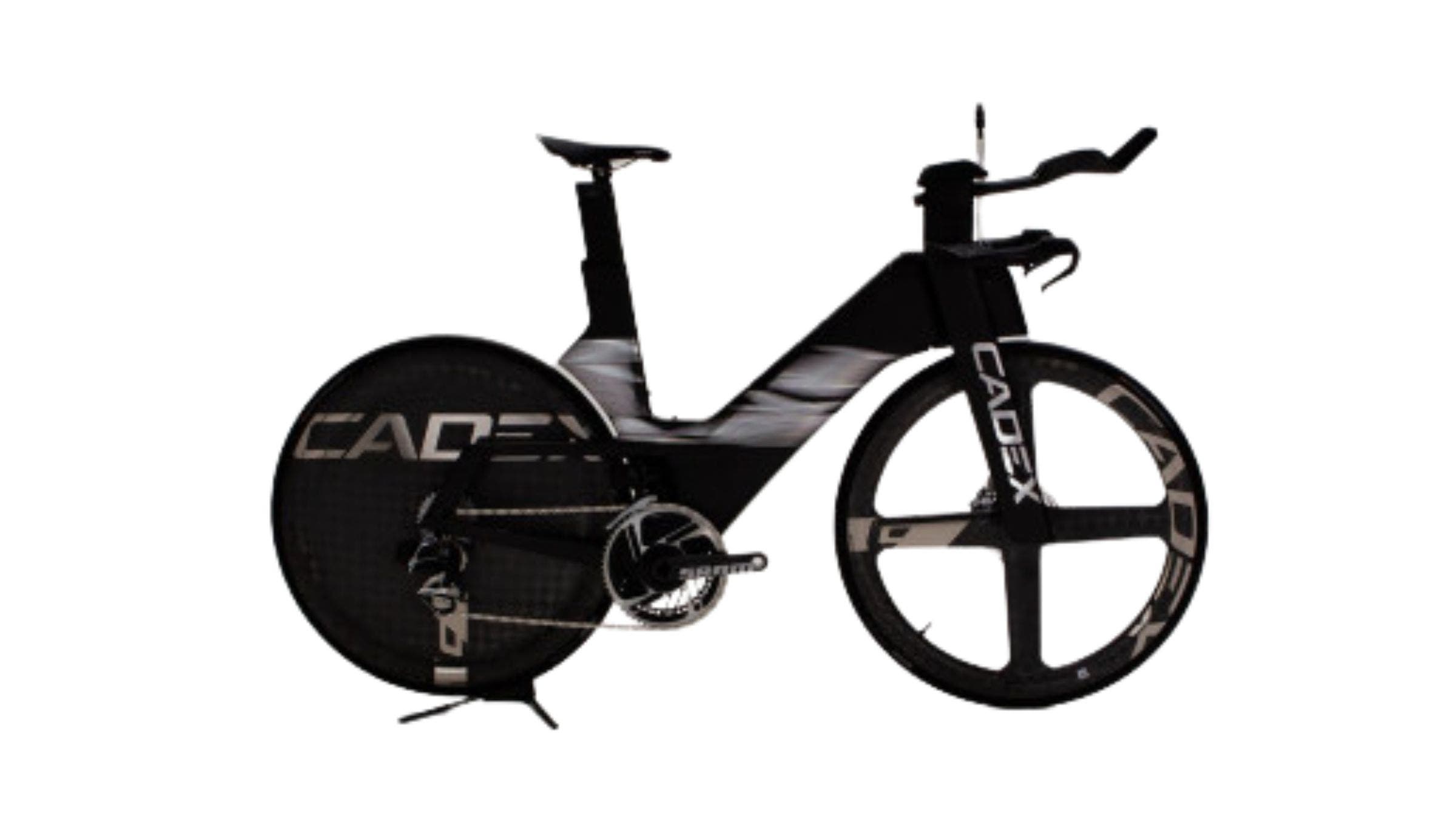
| Best Triathlon Bikes Category | Rating |
| Overall Rating | ★★★ |
| Sizes Offered | 5 |
| Fit Range | ★★★★ |
| Value | ★★★ |
| Comfort | ★★★ |
| Acceleration Stiffness | ★★★ |
| Handling Tightness | ★★★ |
| Stability | ★★★★ |
| Ease of Assembly | Not D2C |
| Best Distance | All distances |
| Integrated Hydration | ★★★★ |
| Volume of Integrated Hydration | 600-1,000 mL |
The new Cadex Tri is the definition of superbike: all-out aerodynamics at almost any cost. Utilizing a rare non-double-diamond frame with an ever-rarer sans-top tube design, this bike combines a unique double-crown fork with horizontal seat stays to drive clean air over the rider’s “dirty” legs. The result is a crazy-fast straightline bike that flies on flats and in low- to mid-speed winds and has tons of tri-specific features that long-course triathletes would love: storage for up to 10 gels, between 600-1000ml of internal hydration storage, and a built-in toolkit.
Elsewhere, this is a surprisingly simple bike to travel with and fit – using a mostly modular front end atop that unusual fork design. However, when it comes to handling predictability, ride smoothness, and cornering, this is a bike that takes a little getting used to, particularly if you’ve spent most of your tri life on a traditional “diamond” design. If you want to go fast, and you’re willing to put in the work, you won’t find a better, more aerodynamic, design.
Read more in our extended review of the Cadex Tri bike.
A2 Bikes SP 1.3
$7,273, weight 22 lbs. (size XL), SRAM Force AXS 12-speed build, Zipp 303 S Wheels
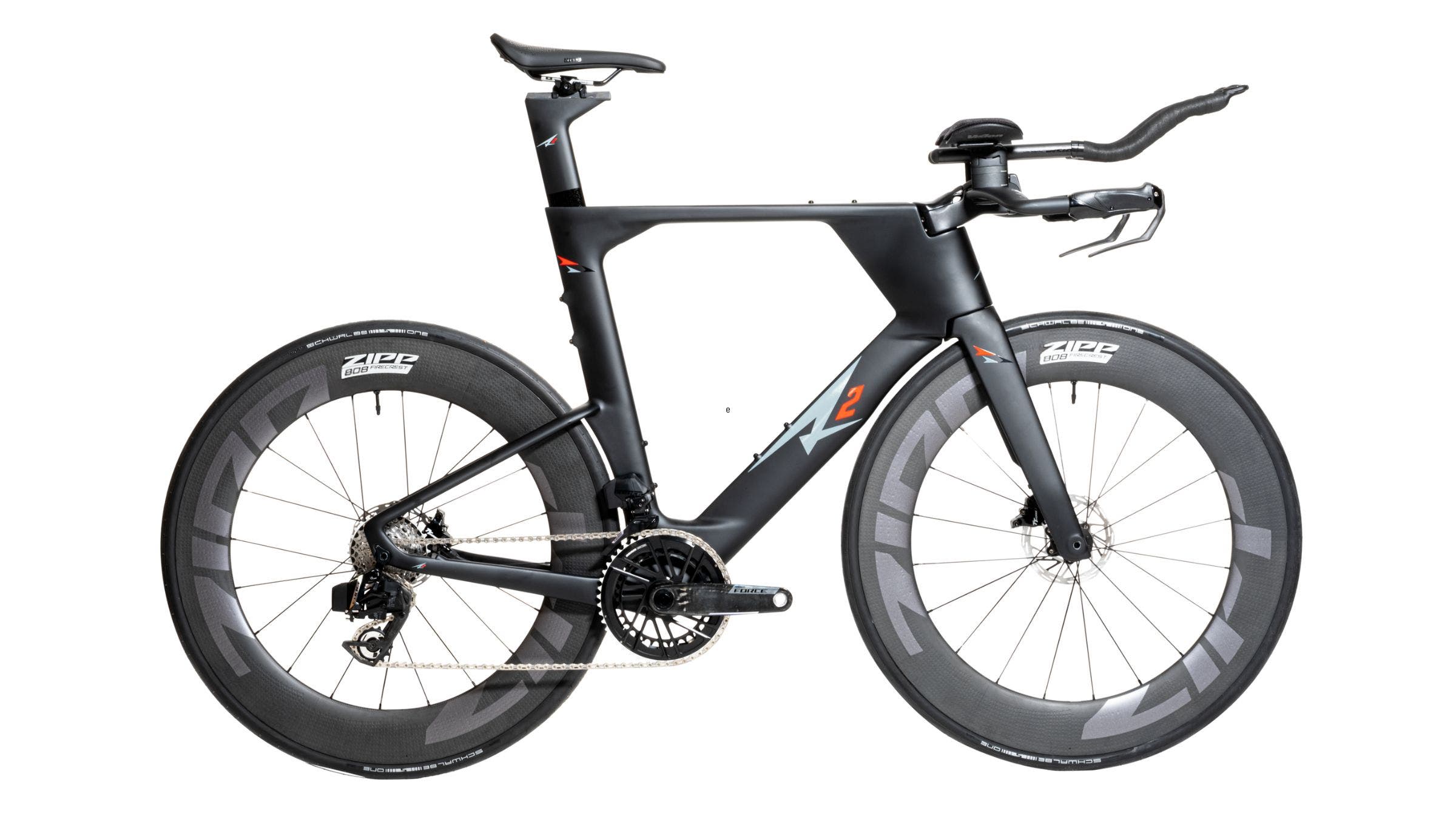
| Best Triathlon Bikes Category | Rating |
| Overall Rating | ★★★★ |
| Sizes Offered | 4 |
| Fit Range | ★★★★★ |
| Value | ★★★★★ |
| Comfort | ★★★ |
| Acceleration Stiffness | ★★★ |
| Handling Tightness | ★★★ |
| Stability | ★★★ |
| Ease of Assembly | ★★★★ |
| Best Distance | All distances |
| Integrated Hydration | None |
| Volume of Integrated Hydration | None |
With the cost of top-end supermachines now rivaling the price of a new car, it’s refreshing to see Portland, Oregon’s A2 Bikes building high-performance race bikes for 15-20% less than comparable big-name models. Especially when they come with SRAM Force components, disc brakes, and Zipp wheels. And especially at a moment when tariffs are hurting every manufacturer sourcing parts from Asia – which is basically every bike maker on the market.
But competitive pricing isn’t A2’s only calling card. The SP line provides outstanding fit flexibility across a wide range of body types, with simple adjustments and DIY-friendly videos that enable non-engineers to dial in a decent position within an hour or two of receiving the bike. Thanks to a sliding seatpost head and innovative headset design, there’s a whopping 140mm of fore/aft adjustability alone. The bike also comes with aerobar risers to adjust cockpit height, though anyone looking to mimic the trend toward extra-tall stacks should note that the SP 1.3’s highest standard setting puts you in a fairly aggressive tuck.
A2 touts the quality of its carbon, which is sourced directly by founder AJ Alley from Taiwan, and the aerodynamics of a frame that features sleek lines, fairly traditional geometry, and refreshingly unostentatious aesthetics. Over three months of training and racing, the SP 1.3 provided a solid all-around ride, with average road vibration, consistent tracking at high speeds, and more dependable handling in windy conditions and around tight corners than our tester experienced with the previous generation SP 1.2.
Trek Speed Concept SLR 7 Gen 3
$9,500, 19lbs. 12oz. (size M, no hydration), Ultegra Di2 Build, Bontrager Aeolus Pro 51 Wheels
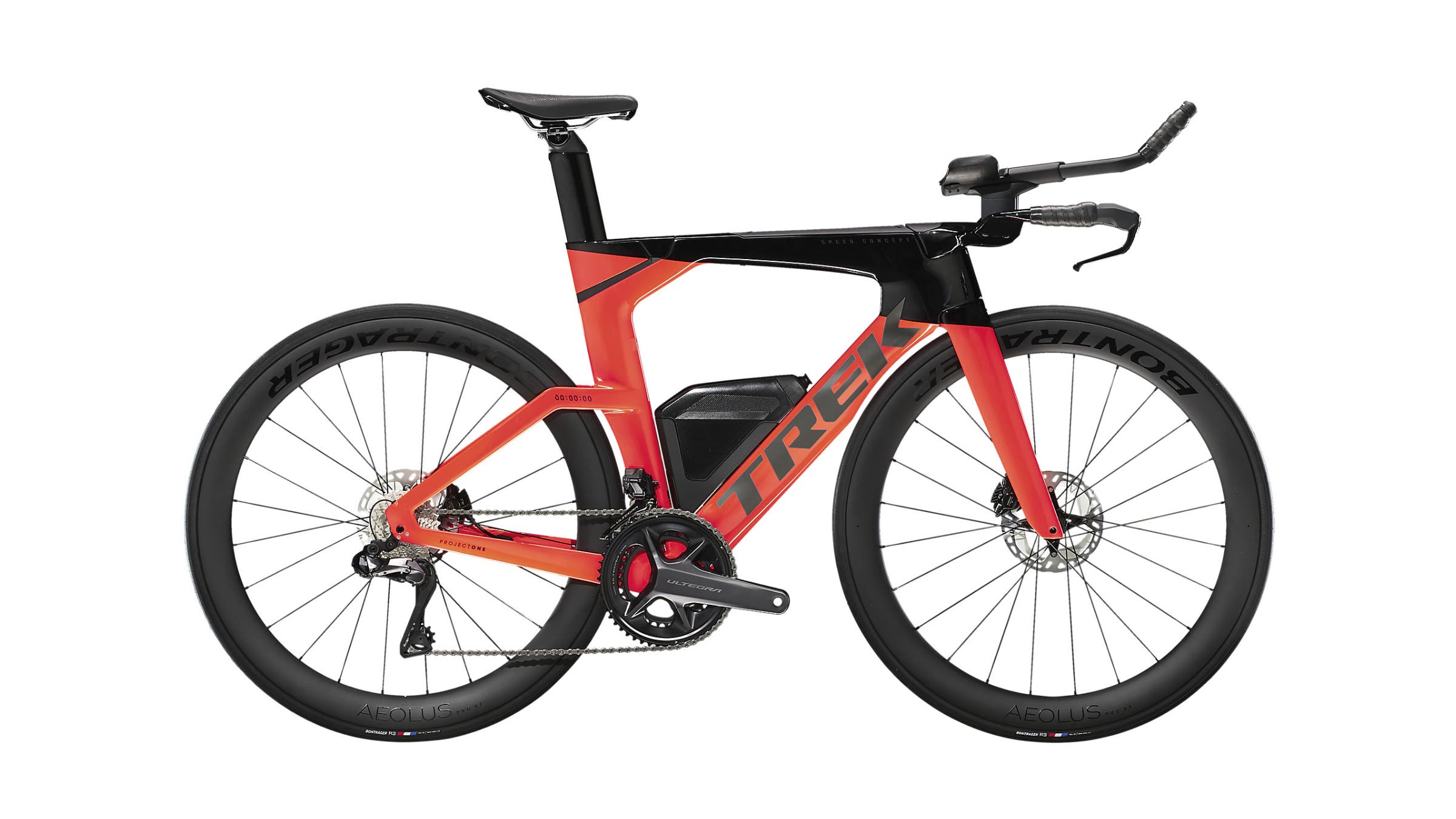
| Best Triathlon Bikes Category | Rating |
| Overall Rating | ★★★★ |
| Sizes Offered | 4 |
| Fit Range | ★★★ |
| Value | ★★★ |
| Comfort | ★★★★ |
| Acceleration Stiffness | ★★★★ |
| Handling Tightness | ★★★★ |
| Stability | ★★★★★ |
| Best Distance | All distances |
| Integrated Hydration | ★★★ |
| Volume of Integrated Hydration | 770 mL |
It took them long enough, but Trek finally added disc brakes to their well-loved Speed Concept line of tri bikes. The good news is they pulled it off well (and added some fun gimmicks to make it worth the wait), but the bad news is if you want in on a new Speed Concept, you’ll be parting with at least $9k of your hard-earned cash. Much like previous versions of the Speed Concept, however, Trek has put together a tight, stable, smooth, and nearly perfect tri bike that’s tough to find real faults with.
The most interesting feature on this new iteration has to be the IsoSpeed coupler/suspension system that reduces high- and mid-range road vibrations. The coupler has been present on many of Trek’s road bikes for years – to varying effect – but has puzzingly been left out of the tri line, where it could potentially do the most good. That said, it’s a good first try, but without any adjustability or way to tune the ride, your mileage may vary on its effectiveness. The bike is mostly smooth, but we were still surprised by larger bumps that took us out of our comfy zone in the super-stable and connected integrated cockpit. Elsewhere, we loved the built-in downtube hydration bottle (and handy hidden tool compartment), and felt just as good cranking hard with our heads down in the aerobars as we did standing up and twisting the basebars up climbs.
Read more in our extended review of the Trek Speed Concept SLR 7 Gen 3.
More of the Best Triathlon Bikes
- A Deep Dive Into The New Quintana Roo X-PR
- What Do You Get For $17,000? Our Hands-On Review of the New Felt IA 2.0
- A Deep Dive Into the New Ventum One Tri Bike
- A Deep Dive Into Quintana Roo’s V-PR Tri Bike
- Deep Dive: Scott Plasma 6 Triathlon Bike
- Deep Dive: Orbea Ordu M10iLTD Triathlon Bike
- Deep Dive: Canyon Speedmax CF SLX Disc
- Reviewed: Canyon Endurance WMN CF SL Disc 7.0
- Reviewed: Argon 18 E-118 Tri+ Triathlon Bike
Triathlon Bike Shopping Advice
- How to Buy a Bike Online
- Road Bike vs. Tri Bike: What’s the Difference?
- What Size Tri Bike Should I Get?
- Reviewed: The Pro’s Closet
- The 5 Key Elements of a Perfect Bike Fit
- A Fit Expert Explains the Various Triathlon Bike Options
- Your Guide To Setting Up A Road Bike for Triathlon
- Here’s Why Most Bike Companies No Longer Make Female-Specific Triathlon Bikes